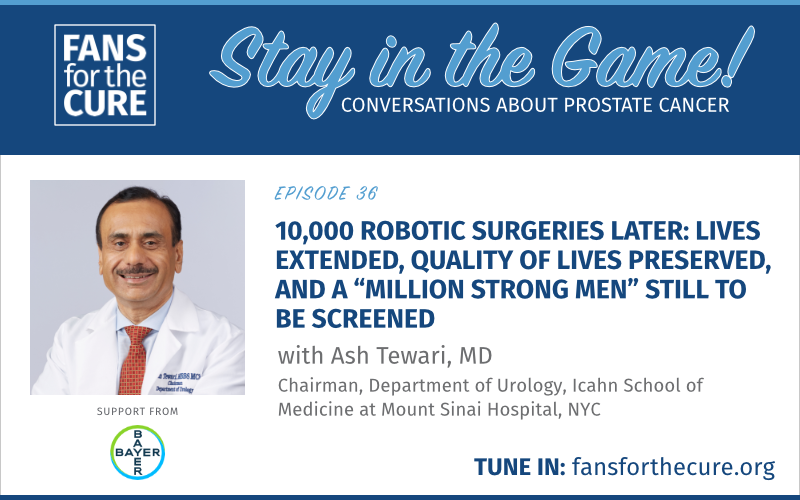To understand the side effects of prostate cancer treatment, it helps to know a few basic facts about the prostate. The prostate is a walnut-size gland that produces fluid that makes up a part of semen. It is located just below the bladder and in front of the rectum, and the urethra – the tube that empties urine from the bladder – runs through it.
When the prostate is treated with either surgery or radiation, the mechanics of urination change. In essence, the system must recalibrate – during which time urinary incontinence is common. Thankfully, the majority of men regain urinary control by six to 12 months following treatment.
Both surgery and radiation for prostate cancer also may affect sexual function. Factors that influence post-treatment sexual dysfunction are increasing age and pre-treatment erectile dysfunction (ED). For all men treated for prostate cancer, 10% to 46% will have some degree of ED following treatment.(i)
Fertility is universally affected by prostate cancer treatment, as the transport system of sperm is disrupted and ejaculation is no longer possible. Sperm, therefore, are unable to make it out of a man’s body for fertilization. Options for men interested in fertility after prostate cancer treatment is sperm banking prior to treatment or direct sperm extraction from the testicle after treatment.
Restoring Urinary Continence
Most men will experience some degree of urinary dysfunction or “leakage” following prostate cancer treatment. For most men, urinary function and incontinence improve gradually, with most men regaining urinary control by one year.(ii) In an attempt to hasten the process, doctors may prescribe exercises to improve the strength of the pelvic muscles (aka Kegel exercises). Some men need additional therapy with a specialized pelvic floor physical therapist to strengthen and stretch muscles involved with holding urine. Men who are good candidates for this additional therapy should ask their urologist for a recommended physical therapist.
For some men, however, problems with urination may continue. In many of these cases, bladder symptoms (frequency, urgency, etc.) may be easily controlled with medication. In other cases, a doctor may want to do further testing, which may lead him/her to recommend a urethral sling (designed to add support to the urethra) or an artificial urethral sphincter, which uses an implanted device to hold the urethra closed until it is deactivated using an implanted pump. These medical devices can greatly improve urinary continence for those men who need a little help. Both the artificial urinary sphincter and male sling are placed by urologists and are often performed as outpatient procedures. Depending on the severity of the incontinence, doctors may prefer one device over the other.
- The male sling involves placement of a synthetic sling under the urethra under slight tension, placing pressure in the urethra and preventing leakage. Patients are typically continent immediately after the procedure and are advised to avoid strenuous activity forone to two weeks following the procedure.
- The artificial urinary sphincter involves placement of three concealed components: the cuff, pump, and balloon reservoir. The fluid filled cuff is placed around the urethra,keeping the urethra closed to prevent leakage of urine. When a patient is ready to urinate,the pump is pressed, and the fluid in the cuff is moved to the balloon reservoir, opening the urethra and allowing a patient to urinate. Like the recovery after placement of a male sling, patients are advised to avoid strenuous activity for one to two weeks following the artificial urinary sphincter procedure. After four to six weeks, the cuff is activated and patients can start using their device.
Resuming Sexual Activity
While many men will regain the ability to obtain erections, this may take a significant amount of time (three to 36 months), and up to 50% of men will require some form of treatment to return their potency.(iii) With that in mind, perhaps the most important first steps are to remain patient and start utilizing ED medications shortly after prostate cancer treatment.
There are many options to help men resume sexual activity. The use of medications (such as Viagra, Cialis, etc.) may help some men, though many will require additional treatment. Further treatment of erectile dysfunction comes in many forms, including medications, vacuum erections device, penile injections, urethral suppositories, and penile implant.
- A vacuum erection device utilizes vacuum suction, drawing blood into the penis; a constriction band is then slid to the base of the penis thus maintaining the erection.
- Alternatively, self–administered medication can be delivered directly to the penis in the form of a urethral suppository (Medicated Urethral System for Erection) or an injectioninto the penile erectile tissue (Intracavernosal Injection), both of which work by increasing the blood flow to the penis.
- Finally, some men elect for the insertion of a penile prosthesis, which involves the implantation of an artificial device to allow for achievement of erection. The surgery typically takes one to two hours and is often done as an outpatient. There are three components of the device, including the prosthesis itself, which is placed in the penis; a concealed fluid filled reservoir; and scrotal pump. All are inserted through a small incision and are concealed on the inside of the body. The recovery time varies, but the device is typically able to be used approximately six to eight weeks after the surgery.
Prostate cancer often changes some aspects of sexual function; however, most men are able to regain function with similar sensations as pre-treatment. While ejaculation is no longer possible, men are able to orgasm as they did prior to treatment. While it may take time to regain sexual function, men dedicated to resumption of sexual activity are able to regain that function with the above treatments, regardless of the severity of their erectile dysfunction.
(i) Ficarra V, Novara G, Ahlering TE, et al. Systematic Review and Meta-analysis of Studies Reporting Potency Rates After Robot-assisted Radical Prostatectomy. European Urology. 2012;62(3):418-430. doi:10.1016/j.eururo.2012.05.046; Skolarus TA, Weizer AZ, Hedgepeth RC, He C, Wood DP, Hollenbeck BK. Understanding Early Functional Recovery After Robotic Prostatectomy. Surgical Innovation. 2011;19(1):5-10. doi:10.1177/1553350611403770.
(ii) Zuniga KB, Chan JM, Ryan CJ, Kenfield SA. Diet and lifestyle considerations for patients with prostate cancer. Urologic Oncology: Seminars and Original Investigations. 2019. doi:10.1016/j.urolonc.2019.06.018.
(iii) Skolarus TA, Weizer AZ, Hedgepeth RC, He C, Wood DP, Hollenbeck BK. Understanding Early Functional Recovery After Robotic Prostatectomy. Surgical Innovation. 2011;19(1):5-10. doi:10.1177/1553350611403770; Skolarus TA, Wolf AM, Erb NL, et al. American Cancer Society prostate cancer survivorship care guidelines. CA: A Cancer Journal for Clinicians. 2014;64(4):225-249. doi:10.3322/caac.21234.


